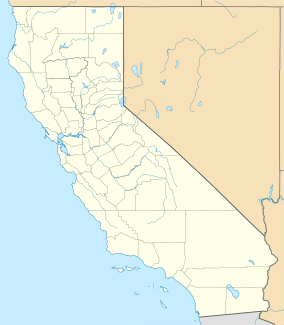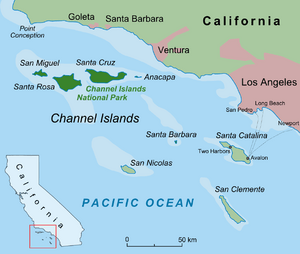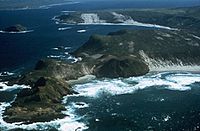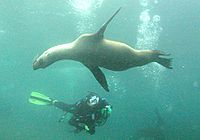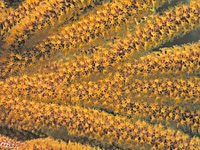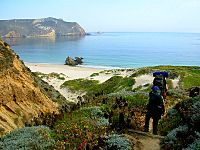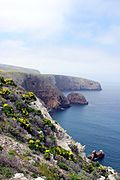Channel Islands National Park facts for kids
Quick facts for kids Channel Islands National Park |
|
|---|---|
|
IUCN Category II (National Park)
|
|
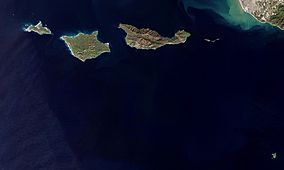
Satellite view of Channel Islands National Park
|
|
| Location | Santa Barbara County & Ventura County, California, United States |
| Nearest city | Santa Barbara |
| Area | 249,561 acres (1,009.94 km2) |
| Established | March 5, 1980 |
| Visitors | 366,250 (in 2018) |
| Governing body | National Park Service |
| Website | Channel Islands National Park |
Channel Islands National Park is made up of five islands off the coast of California in the Pacific Ocean. These islands are part of a larger group of eight. Even though they are close to busy cities, these islands are mostly untouched.
The park covers a huge area, both land and ocean. Most of Santa Cruz Island, the biggest island, is looked after by The Nature Conservancy. The islands are very important for their nature and history. Because of this, they have special titles.
Anacapa and Santa Barbara islands became a national monument in 1938. Later, in 1976, all eight islands were named a biosphere reserve by UNESCO. Finally, on March 5, 1980, five of the islands became the new national park. These five are Anacapa, Santa Barbara, Santa Cruz, San Miguel, and Santa Rosa.
The ocean around the park, up to six nautical miles out, is also a protected area called the Channel Islands National Marine Sanctuary.
Contents
Discovering the History of the Islands
People have lived on the Channel Islands for a very long time. Scientists have found signs of humans from at least 37,000 years ago on Santa Rosa Island. They found old fire pits and even bones from a mammoth that was burned. This shows that ancient people hunted and cooked here.
The oldest human bones found, called Arlington Springs Man, are about 10,000 years old. Later, around 2,000 years ago, large shell mounds appeared. These were piles of shells left by people who ate seafood.
Juan Rodríguez Cabrillo was the first European to see the islands in 1542. At that time, about two to three thousand Chumash people lived on the three northern islands. They had many villages across Santa Cruz, Santa Rosa, and San Miguel.
In 1938, Santa Barbara and Anacapa islands were made a national monument. Then, in 1980, San Miguel, Santa Rosa, and Santa Cruz islands joined them. This created the Channel Islands National Park we know today.
The 1969 Oil Spill
In 1969, there was a big oil spill near the Channel Islands. An oil rig had a problem, and a lot of crude oil spilled into the ocean. It took about 11 days to stop the leak.
This oil spill covered a huge area of the ocean. The oil washed up on the beaches of Anacapa, San Miguel, Santa Rosa, and Santa Cruz islands. It caused a lot of harm to the animals living there. Many seabirds, seals, and dolphins died.
This event was one of the largest oil spills in U.S. history. It led to new rules to protect the ocean and helped create the Environmental Protection Agency. It's important to know that some natural oil seeps, where oil leaks from the seafloor, have always existed around these islands. The Chumash people even used this natural tar for their boats.
Exploring the Islands' Geography
The islands in the park stretch along the Southern California coast. The main park office and visitor center are in Ventura.
The park covers about 249,354 acres. Half of this area is under the ocean! The five islands that make up the park are:
- San Miguel (9,325 acres)
- Santa Rosa (52,794 acres)
- Anacapa (699 acres)
- Santa Barbara (639 acres)
- Santa Cruz (60,645 acres) - Most of this island is managed by The Nature Conservancy.
Weather on the Islands
The Channel Islands have a warm-summer Mediterranean climate. This means they have warm, dry summers and mild, wet winters. The weather is generally pleasant, but it can change quickly, especially on the ocean.
Amazing Plants and Animals
The Channel Islands National Park is home to over 2,000 different kinds of plants and animals. Many of these species are unique and can't be found anywhere else in the world!
Only three mammals are native to the islands:
- The deer mouse
- The spotted skunk
- The island fox
Other special animals include the island fence lizard and the island scrub jay. You can also see harbor seals, California sea lions, and many types of birds like barn owls and brown pelicans.
The ocean around the islands is full of life too. It ranges from tiny plankton to the giant, endangered blue whale, which is the largest animal on Earth! The park is a very important place for protecting these amazing creatures.
Visitor Center
The main visitor center for Channel Islands National Park is located in Ventura Harbor. It's a great place to start your visit!
At the center, you can find out about all five islands. There are exhibits about the native plants, marine life, and the history of the islands. You can also watch a short film that gives you a good overview of the park. The visitor center is open almost every day of the year. Many people visit the center each year to learn about this special place.
Fun Things to Do
Channel Islands National Park offers many exciting activities for visitors. You can go backpacking, camping, or enjoy day hikes. The park is also famous for its amazing sea caves. Kayaking through these caves is a very popular adventure!
The most visited spot for day trips and camping is Scorpion Anchorage on Santa Cruz Island. This is because it's easy to get to by ferry. There's also a new visitor center at Scorpion Ranch.
While summer is popular, winter and spring are also great times to visit. In winter, you might see migrating gray whales. In spring, the islands are covered in beautiful wildflowers. Autumn is perfect for diving because the days are sunny, and the ocean water is clear.
It's important to be careful when visiting the park because ocean conditions can change quickly. The park service recommends that new visitors use caution. They also suggest using authorized guide services if you're not experienced.
Not many people visit the islands themselves, but many more enjoy sailing in the waters around the park.
Gallery
-
Diver and juvenile sea lions, Anacapa Island
-
Anacapa Island Light viewed from the west side of the island
Park Vessels
The Channel Islands National Park uses several boats to patrol and manage the waters around the islands. These include:
- Surf Ranger (74 feet long)
- Pacific Ranger (56 feet long, used for research diving)
- Sea Ranger II (58 feet long)
- Ocean Ranger (100 feet long)
See also
 In Spanish: Parque nacional Islas del Canal para niños
In Spanish: Parque nacional Islas del Canal para niños


